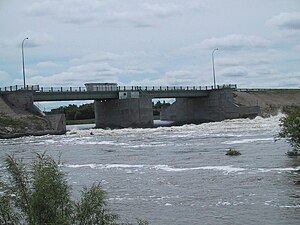

|
mNo edit summary
|
m CDN is not a currency, CAD is.
|
||
| Line 2: | Line 2: | ||
The '''Red River Floodway''' is an artificial [[flood control]] waterway in [[Canada]] first used in 1969. It is a 47-km channel which, during flood periods, diverts part of the [[Red River of the North|Red River]]'s flow around the city of [[Winnipeg]], [[Manitoba]] to the east and discharges back into the Red River below the dam at [[Lockport, Manitoba|Lockport]]. It can carry floodwater at a rate of up to 2,550 cubic metres per second. It was built partly in response to the disastrous [[Red River flood, 1950]]. |
The '''Red River Floodway''' is an artificial [[flood control]] waterway in [[Canada]] first used in 1969. It is a 47-km channel which, during flood periods, diverts part of the [[Red River of the North|Red River]]'s flow around the city of [[Winnipeg]], [[Manitoba]] to the east and discharges back into the Red River below the dam at [[Lockport, Manitoba|Lockport]]. It can carry floodwater at a rate of up to 2,550 cubic metres per second. It was built partly in response to the disastrous [[Red River flood, 1950]]. |
||
The Floodway was pejoratively [[nickname]]d "'''Duff's Ditch'''" by opponents of its construction, after [[Premier]] [[Duff Roblin]], whose [[Progressive Conservative Party of Manitoba |Progressive Conservative]] government initiated the project. It was completed in time and under budget. Subsequent events have vindicated the plan. Used over 20 times in the 37 years from its completion to 2006, the Floodway has saved an estimated $10 billion ( |
The Floodway was pejoratively [[nickname]]d "'''Duff's Ditch'''" by opponents of its construction, after [[Premier]] [[Duff Roblin]], whose [[Progressive Conservative Party of Manitoba |Progressive Conservative]] government initiated the project. It was completed in time and under budget. Subsequent events have vindicated the plan. Used over 20 times in the 37 years from its completion to 2006, the Floodway has saved an estimated $10 billion (CAD) in flood damages. The term is still used affectionately. |
||
Construction of the Floodway started on [[October 6th]], [[1962]] and finished in March [[1968]], was a major undertaking with 76.5 million cubic metres of earth excavated—more than what was moved for the [[Suez Canal]]. |
Construction of the Floodway started on [[October 6th]], [[1962]] and finished in March [[1968]], was a major undertaking with 76.5 million cubic metres of earth excavated—more than what was moved for the [[Suez Canal]]. |
||

The Red River Floodway is an artificial flood control waterway in Canada first used in 1969. It is a 47-km channel which, during flood periods, diverts part of the Red River's flow around the city of Winnipeg, Manitoba to the east and discharges back into the Red River below the dam at Lockport. It can carry floodwater at a rate of up to 2,550 cubic metres per second. It was built partly in response to the disastrous Red River flood, 1950.
The Floodway was pejoratively nicknamed "Duff's Ditch" by opponents of its construction, after Premier Duff Roblin, whose Progressive Conservative government initiated the project. It was completed in time and under budget. Subsequent events have vindicated the plan. Used over 20 times in the 37 years from its completion to 2006, the Floodway has saved an estimated $10 billion (CAD) in flood damages. The term is still used affectionately.
Construction of the Floodway started on October 6th, 1962 and finished in March 1968, was a major undertaking with 76.5 million cubic metres of earth excavated—more than what was moved for the Suez Canal.
During the "Flood of the Century" in 1997, the volume of flood water exceeded the Floodway's design specification. Water lapped within inches of the city's dikes, and an extended dike (commonly known as the "Brunkild Z-dike") had to be built to prevent flooding from reaching around the southwest corner of the city. Primarily as a result of the floodway, the city suffered little flood damage.
In 2003, the province announced plans to expand the floodway, increasing its flow capacity from 2,550 m³/s to 4,000 m³/s, mostly by widening it. As of November 2005 work has begun on the expansion of the floodway.